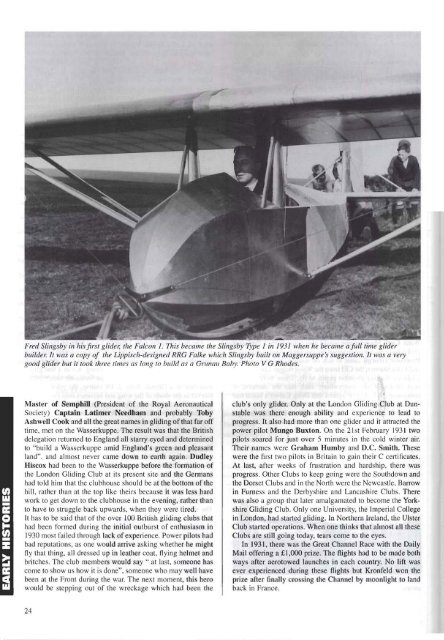VGC News/Newsletters - Lakes Gliding Club
VGC News/Newsletters - Lakes Gliding Club
VGC News/Newsletters - Lakes Gliding Club
Create successful ePaper yourself
Turn your PDF publications into a flip-book with our unique Google optimized e-Paper software.
Fred Slingsby in his first glider, the Falcon I. This became the Slingsby 7)pe 1 in 1931 when he became a full time glider<br />
builder. It was a copy of the Lippisch-designed RRG Falke which Slingsby built on Maggersuppe's suggestion. 1t was a very<br />
good glider but it took three limes as long 10 build as a Grunau Baby. Pholo V G Rhodes.<br />
Master of Semphill (President of the Royal Aeronautical<br />
Society) Captain Latimer Needham and probably Toby<br />
AshweIl Cook and atl the great names in gliding of that far off<br />
time, met on the Wasserkuppe. The result was that the British<br />
delegation returned to England all starry eyed and determined<br />
to "build a Wasserkuppe amid England's green and pleasant<br />
land". and almost never came down ,to earth again. Dudley<br />
Hiscox had been to the Wasserkuppe before the formation of<br />
the London <strong>Gliding</strong> <strong>Club</strong> at its present site and the Germans<br />
had told him that the clubhouse should be at the bot,tom of the<br />
hill, rather than at the top like theirs because it was less hard<br />
work to get down to the clubhouse in the evening, rather than<br />
to have to struggle back upwards, when they were tired.<br />
It has to be said that of the over 100 British gliding clubs that<br />
had been formed during the initial outburst of enthusiasm in<br />
1930 most failed through lack of experience. Power pilots had<br />
bad reputations, as one would arrive asking whether Ile m~ght<br />
fly that thing, all dressed up in leather coat, flying helmet and<br />
blitches. The club members would say" at last, someone has<br />
come to show us how it is done", someone who may well have<br />
been at the Front dUling the war. The next moment, this hero<br />
would be stepping out of the wreckage which had been the<br />
club's only glider. Only at the London <strong>Gliding</strong> <strong>Club</strong> at Dunstab;le<br />
was there enough ability and experience to lead to<br />
progress. It also had more than one glider and it attracted the<br />
power pilot Mungo Buxton. On the 21 st February 1931 two<br />
pilots soared for just over 5 minutes in the cold winter air.<br />
Their names were Graham Humby and D.e. Smith. These<br />
were the first two pilots in Britain to gain their C certificates.<br />
At last, after weeks of frustration and hardship, there was<br />
progress. Other <strong>Club</strong>s to keep going were the Southdown al1d<br />
the Dorset <strong>Club</strong>s and in the North were the Newcastle, Barrow<br />
in FUl'ness and the Derbyshire and Lancashire <strong>Club</strong>s. There<br />
was also a group that later amalgamated to become the Yorkshire<br />
<strong>Gliding</strong> <strong>Club</strong>. Only one University, the Imperial College<br />
in Lond.on, had started gliding. In Northern Ireland, the Ulster<br />
<strong>Club</strong> started operations. When one thinks that almost .all these<br />
<strong>Club</strong>s are still going today, tears come to the eyes.<br />
In 1931, there was the Great Channel Race with the Daily<br />
Mail .offering a £ 1,000 prize. The flights had to be made both<br />
ways after aerotowed launches in each country. No lift was<br />
ever experienced during these flights but Kronfeld won the<br />
prize after finally crossing the Channel by moonlight to land<br />
back in France.<br />
24

















